Style Check! Pt 4: Mediterranean Style
The final feature in our Style Check! series takes a look at the Mediterranean décor style. When you take into consideration that there are 22 countries that make up the Mediterranean region, the range of design influences is not only vast but also spans two continents; Europe and Africa. However, there are elements common to each that define this ever-popular and homely décor style.

A neutral palette made interesting with layers of texture and accents of blue that reflect the sky and sea. Image: houzz.com
When selecting accessories and ornaments for a Mediterranean home, it's important to choose pieces that reflect the region's cultural heritage and natural surroundings. The combination of vibrant ceramics, ornate metalwork, natural elements, and traditional crafts helps create an inviting and visually appealing and authentic aesthetic.
That being said, your exact choice of colours and way of accessorising a space depends strongly on the region you may want to emulate. Mediterranean décor is characterized by a colour palette of hues reminiscent of the land, sea, and sky. This combination creates a serene and inviting atmosphere that is perfect for the Mediterranean-inspired space.
The distinctive architectural styles of the region have a timeless appeal that is easy to work with. Exposed wooden beams and ceilings are common and add a rustic charm that either perfectly complements your furniture choice, or acts as a dramatic counterpoint to more modern, contemporary pieces. Whether you are a fan of antiques, rustic chic, or sleek modernism, they can all be easily incorporated into this encompassing style.
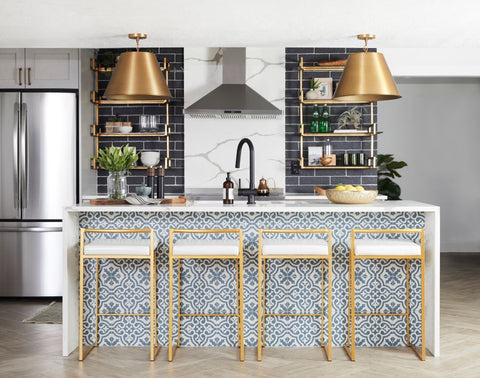
The fresh tile frontage of this centre island is indicative of Mediterranean style - Photo Image: Nicole Gulerat for Andrea West Design
Patterned tiles are an important feature in Mediterranean style that has played a part in the architecture of the region throughout history. From as early as 4BC the early Greeks, and later the Romans, were using decorative tiling extensively, often depicting scenes from mythology. These tiles, known as "tesserae," were made from various materials, including terracotta, marble, and glass. These were an integral part of the decorative style and used in the construction of villas, bathhouses, and public buildings throughout the Mediterranean.
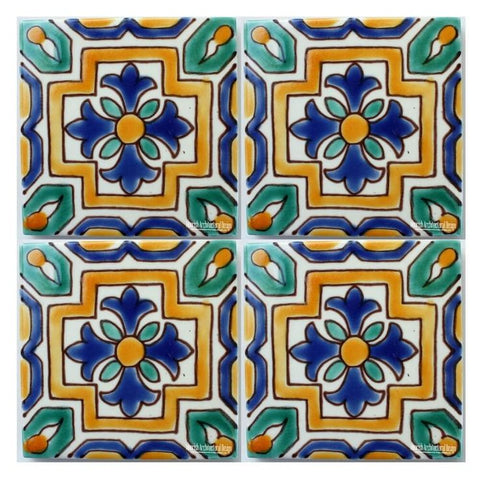
However, it was during the Islamic period, particularly under Moorish rule in Spain, that patterned tiles reached their zenith in the Mediterranean. The Moors brought their intricate decorative tilework traditions from North Africa and the Middle East to the Iberian Peninsula. This style, known as "Zellige" or "Azulejo," featured geometric and floral patterns in vibrant colours, typically in shades of blue, green, and white. The Alhambra palace in Granada, Spain, is a stunning example of Moorish tilework, showcasing intricate beauty and skillful craftsmanship.
These vibrant tiles, often with intricate geometric or floral designs, inject a burst of colour and visual interest into the space and can often be seen on floors, backsplashes and staircases.

An almost minimal approach to Mediterranean décor with the predominantly neutral tones offset by the natural greens of carefully placed plants. Image: Vevano.com
The colour usage in Mediterranean homes reflects the vibrant and sun-drenched environment of the region. It is characterized by a harmonious blend of warm, earthy tones, bright and saturated colours, and subtle accents that evoke the Mediterranean landscape and lifestyle
Colours like terracotta, ochre, sandy beige, and warm browns are commonly used on exterior walls and as foundational colours throughout the interior. These earthy hues create a sense of warmth and connection to the Mediterranean landscape.
White is a prominent colour in Mediterranean homes, especially for walls and architectural elements. Crisp white walls help reflect the intense sunlight, creating a bright and airy atmosphere. Light neutrals such as soft beiges and creams are also used to maintain a sense of lightness and to provide a neutral backdrop for colourful accents.
Blue is a quintessential colour in Mediterranean design, symbolizing the sky and sea. Various shades of blue, ranging from deep navy to vibrant azure, are incorporated into interior and exterior elements. Blue is often seen on doors, shutters, window frames, and decorative tiles, creating a refreshing contrast against the white or earthy surroundings.

A fun way to add a pop of bold colour is with the Silhouette side table from the Leonardo – Tables by Design ‘Bright’ collection.
Mediterranean homes are known for incorporating accents that bring energy and liveliness to the space. Splashes of colour such as sunny yellows, vibrant oranges, rich reds, and deep greens can be found in decorative tiles, textiles, artwork, and accessories. These bold accents add warmth and visual interest to the overall design scheme.
Inspired by the lush Mediterranean vegetation, touches of green are often introduced in Mediterranean homes. This can be achieved through indoor plants, potted herbs, or incorporating green elements in fabrics, upholstery, or decorative items. Green adds a fresh and natural touch, complementing the warm colour palette.
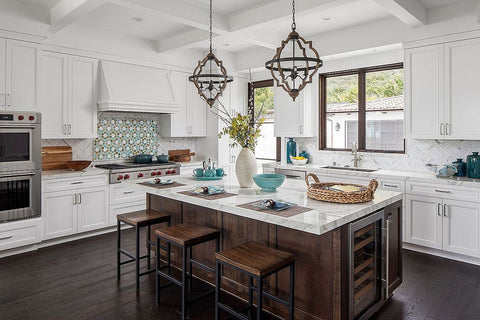
Metal pendants with Moorish overtones compliment the tile splash-back in this Mediterranean kitchen. Image: Christine Vroom Interiors (Los Angeles). Source: homecrux.com
Mediterranean design also embraces metallic accents, typically in warm tones like bronze, copper, and gold. These metallic finishes can be seen in lighting fixtures, decorative hardware, and ornamental details. They add a touch of elegance and enhance the warm and inviting atmosphere to any space.
It's important to note that colour usage in Mediterranean homes can vary depending on specific regional influences and personal preferences. While the overall palette tends to be warm and vibrant, there is room for individual interpretation and customization to suit different tastes and styles.
Textiles play a significant role, adding texture, colour, and comfort to living spaces. The region's diverse cultural influences and rich textile traditions have contributed to a wide range of fabrics and patterns used in Mediterranean interior design.
The style often feature textiles made from natural fibres like cotton, linen, and wool. These fibres are valued for their breathability, durability, and ability to withstand the warm climate. Linen, in particular, is a popular choice for curtains, tablecloths, and upholstery due to its lightweight and airy qualities.

The strong architectural features are emphasised with the use of strong patterns in the rug and bold lines of the furnishings and accessories. Image Vevano.com
Mediterranean-inspired Prints are often showcased in vibrant prints and patterns inspired by the region's flora, fauna, and cultural heritage. Typical motifs include intricate geometric patterns, stylized floral designs, local landscapes, and Mediterranean tile patterns. These prints can be found on upholstery fabrics, draperies, bedspreads, and decorative pillows, infusing the space with a sense of regional charm.
Embroidered textiles are commonly used to add a touch of craftsmanship and artistry to interiors. Intricate embroidery work can be found on items like table linens, decorative pillow covers, and traditional garments like caftans. Embellishments such as tassels, fringes, and pom-poms are also incorporated into textiles to enhance their visual appeal and add a playful element.
Colourful throws and rugs are essential components of Mediterranean home decor. These textiles often feature bold patterns, vivid colours, and intricate weaves. They can be used to add warmth, texture, and a vibrant focal point to living areas, bedrooms, and outdoor spaces like terraces or courtyards. Traditional kilim rugs and Moroccan-style carpets are popular choices for their unique patterns and craftsmanship.
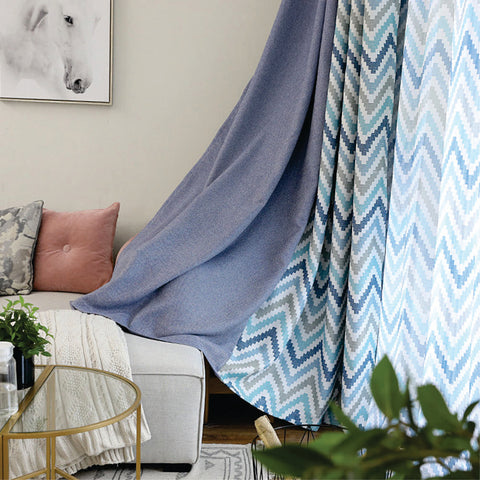
Image: Mediterranean weaves in bright colours and soft fabrics from Homelava.com
Given the Mediterranean climate, curtains and draperies are given light and airy window treatments. Sheers, voiles or muslin are popular as they allow ample natural light while providing privacy. These curtains create a soft and breezy ambience while filtering sunlight and adding a touch of elegance.
Woven baskets made from materials like seagrass, rattan, or palm leaves are frequently used in Mediterranean homes for storage, organizing items, or as decorative elements. These baskets provide a rustic and natural touch, complementing the overall aesthetic while serving functional purposes.
When incorporating textiles, it is common to mix and layer different textures, colours, and patterns to create an eclectic and inviting atmosphere. The use of natural fibres, bold prints, embroidery, and traditional craftsmanship all contribute to the distinctive charm and warmth of Mediterranean interior design.
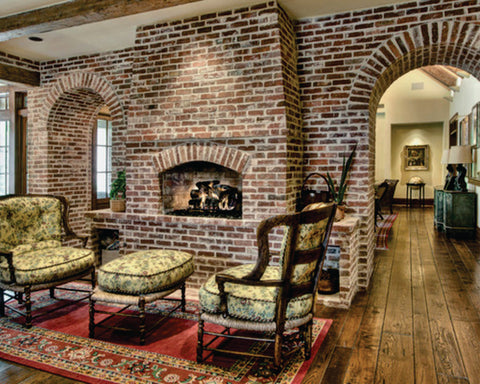
Richly coloured rugs and upholstery in a cosy setting – Image Dwellingdecor.com
Accessories and ornaments play a vital role in enhancing the local aesthetic of a home, adding character, charm, and a sense of cultural heritage, history, nature, and artisanal traditions.
The Med is renowned for its beautiful ceramics and pottery. Hand-painted tiles, colourful vases, bowls, and plates featuring intricate patterns and motifs are popular choices. These pieces can be displayed on shelves, tables, or as wall art, infusing the space with a touch of local craftsmanship.
Iconic Moroccan-style lanterns with intricate metalwork and colourful glass panels are a popular choice for adding a warm and exotic ambience. They can be hung from ceilings or placed on tabletops, creating beautiful pools of light and shadow.

A courtyard walkway perfectly accessorised with Moorish lanterns, large terracotta planters, interesting accessories and simple furnishings. Image: Vevano.com
Mediterranean homes lend themselves to all forms of wall art. This can include framed paintings or prints depicting local landscapes, seascapes, or regional scenes. Handwoven tapestries, decorative mirrors with ornate frames, iconoclastic figurines and carvings, or even wall-mounted ceramics and plates can add interest and excitement.
Wrought iron accents bring a touch of old-world elegance to Mediterranean interiors. Ornate ironwork can be seen in decorative pieces such as candle holders, wall sconces, balustrades and furniture. These intricate designs often feature scrollwork, floral motifs, and geometric patterns.

Image: The Casablanca side table from Leonardo – Tables by Design echoes the Moroccan tile motifs. The Casablanca tables are available on special order only.
Mediterranean homes often incorporate coastal walk finds like seashells and interesting driftwood, dried flowers and branches to create a rustic and organic feel. These elements can be arranged in vases, used as table centrepieces, or displayed on shelves, adding a touch of nature to the interior.
As previously discussed, mosaic tiles and designs are synonymous with the Mediterranean style. Small mosaic pieces can be incorporated into tabletops, decorative trays, or accents on mirrors or picture frames. These colourful and intricate patterns create a stunning visual impact.

Available on special order only, The Madrid dining table from Leonardo – Tables by Design combines the warmth of solid wood and the interest of the shaped metal frame.
Textiles, such as embroidered pillow covers, cushion covers, and table runners can add a pop of colour and pattern, while tassels, fringes, and pom-poms can be used on curtains, lampshades, or bedding to add a playful and bohemian touch.
Indoor plants like olive trees, potted herbs, succulents, and citrus trees are not only decorative but also evoke the natural beauty of the Mediterranean landscape. These plants can be placed in terracotta pots or decorative planters, bringing freshness and a connection to the outdoors.

A beautifully curated selection of accessories for the Mediterranean home
When selecting accessories and ornaments for a Mediterranean home, it's important to choose pieces that reflect the region's cultural heritage and natural surroundings. The combination of vibrant ceramics, ornate metalwork, natural elements, and traditional crafts helps create an inviting and visually appealing and authentic aesthetic.
Overall, Mediterranean décor styles offer a harmonious blend of colours, textures, and materials that transport you to the sun-drenched shores of the Mediterranean. Whether you're aiming for a rustic Tuscan farmhouse, a breezy Greek island retreat, or a vibrant Moroccan riad, Mediterranean décor creates a welcoming and relaxing ambience that celebrates the timeless beauty of this enchanting region.
We hope that you have enjoyed this article, and the whole Style Check! Series. With the winter weather snapping at our heels, maybe a little Mediterranean warmth is the ideal way to brighten the season.
Whatever décor style best suits your lifestyle, Leonardo – Tables by Design has a table for the occasion. With over three decades of experience, we not only have an extensive online range, but an archive of designs that are available on special order and can be customised to perfectly suit your design brief.
All the best until next month,
Yours in Style - Frank
























